Comptroller Kevin Lembo Archive > News
COMPTROLLER LEMBO PROJECTS $300,000 SURPLUS FOR FY 15In a letter to Gov. Dannel P. Malloy, Lembo said he is in general agreement with the Office of Policy and Management's (OPM) projection after analyzing available data through the close of the first quarter of the fiscal year.
General Fund spending this fiscal year is expected to grow 3.3 percent over last fiscal year, while revenue is projected to grow 2.6 percent over the prior fiscal year, Lembo said.
"Based on spending patterns through the first quarter of Fiscal Year 2015, total General Fund expenditures are within budget targets," Lembo said. "As the fiscal year progresses, it is likely that various budget line items will see either additions or reductions that will total to the forecasted aggregate General Fund spending level.
"I am pleased to report better than expected receipts in both the withholding portion of the income tax and the sales tax, which are two of the largest revenue components of the General Fund.
"Withholding receipts were up 4.6 percent - reinforcing reports that the state posted strong job growth in September. Sales tax revenue was also up 6.7 percent in September from the same month last year.
"While these trends are not yet sufficiently established to justify a change in the current forecast, they provide additional assurance that the budget remains in balance," Lembo said.
Lembo noted that his office, along with the Office of Policy and Management (OPM) and the State Treasurer, will continue to monitor the status of certain federal Medicaid reimbursements anticipated this year that have been partially deferred pending a review of claim methodology by the Department of Social Services (DSS) and the federal Centers for Medicare & Medicaid Services.
As noted previously, Lembo said his office will also continue to monitor the cost of retiree health benefits closely.
In addition to the enhanced job growth and withholding patterns, Lembo highlighted state and national economic indicators from federal and state Departments of Labor and other sources that show:

• The gain in the payroll-driven withholding portion of the
income tax is consistent with a gradual improvement in the state's employment
outlook. Through the first three months of Fiscal Year 2015, the withholding tax
was running 3.4 percent above the same period last year. The withholding gains
have continued to fall short of the increases posted during the previous
recovery.
• The large revenue increases in Fiscal Years 2011 and 2012 were almost entirely
attributable to higher tax rates. Net of those tax increases, withholding
receipts were stagnant in both Fiscal Year 2011 and Fiscal Year 2012. That
stagnation also continued through Fiscal Year 2013.
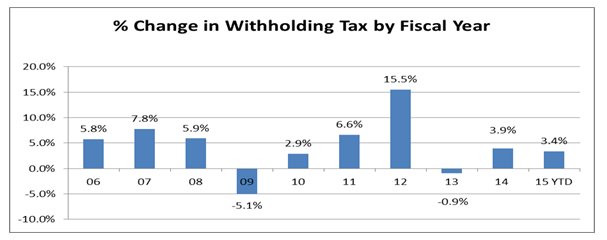
• The graph below depicts the stabilization of job growth in
Connecticut going into the second half of Fiscal Year 2014. The state has gained
jobs in seven of the last eight months. September's preliminary gain of 11,500
jobs was notably large.
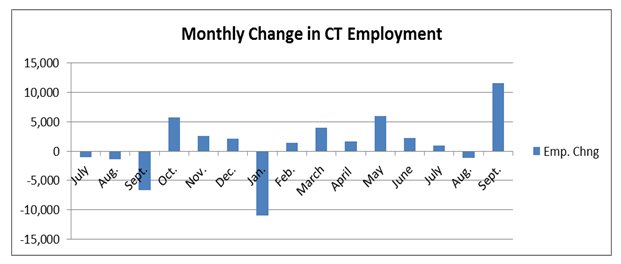
According to the Department of Labor, Connecticut has now
recovered 85,300 positions,
• According to the Department of Labor, Connecticut has now recovered 85,300
positions, or 71.6 percent of the 119,100 seasonally adjusted total nonfarm jobs
that were lost in the state during the March 2008 - February 2010 recession.
• Connecticut's jobs recovery is now 55 months old and is averaging
approximately 1,551 jobs per month overall since February 2010. The private
sector has regained employment at a faster pace and has now recovered 93,700
(83.7 percent) of the 112,000 private sector jobs that were lost during the same
recessionary downturn (1,704 per month pace).
• At 1,679,200 nonfarm jobs for September 2014, the state needs to reach the
1,713,000 level to start an official nonfarm employment expansion. This will
require an additional 33,800 jobs going forward. A total of just 18,300
additional private sector positions are needed to have a fully restored private
sector.
• The table below shows the distribution of employment gains and losses by major
employment sector over the latest 12-month period ending in September.
• Job additions in Connecticut during this period total 26,100.
| Job Gains Latest 12 months | Job Losses Latest 12 months | ||
|---|---|---|---|
| Sector | Sector | ||
| Transp. & Public Utility | 8,300 | Financial Activities | -1,100 |
| Leisure & Hospitality | 6,600 | Information | -100 |
| Education & Health | 5,300 | ||
| Construction | 3,500 | ||
| Government | 1,600 | ||
| Other Services | 1,100 | ||
| Prof & Business Service | 700 | ||
| Manufacturing | 200 |
• U.S. employment has been advancing at a rate of 2 percent
over the twelve-month period ending in September; Connecticut's employment
growth is close to the national rate at 1.6 percent for the same period.
• Connecticut's unemployment rate dropped to 6.4 percent in September; the
national unemployment rate was 5.9 percent. Connecticut's unemployment rate has
continued to decline from a high of 9.5 percent in October 2010.
• There are approximately 119,800 unemployed workers in Connecticut. A low of
36,500 unemployed workers was recorded in October of 2000. The number of
unemployed state workers hit a recessionary high of 181,300.
![]()
• The Department of Labor calculates that Connecticut's
average hourly earnings rose 33 cents or 1.2 percent to $28.26 from September of
last year. Average private weekly pay rose to $958.01, up $5.60 or 0.6 percent
from September 2013.
• Average hourly earnings of private sector workers have struggled to establish
a consistent growth trend over the last two years.
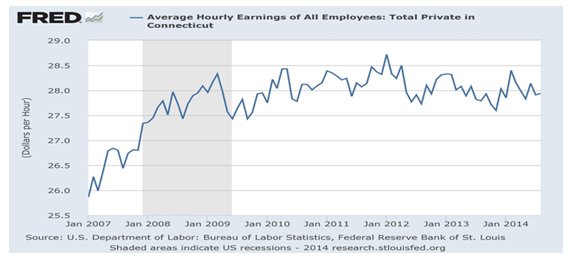
• As in past months, the strongest job growth sector in
September (transportation and public utilities) has experienced a declining wage
trend since 2012. While the sector shedding the most jobs (financial activities)
has posted a general upward trend in pay. Actual pay is also significantly
higher in the job loss sector.
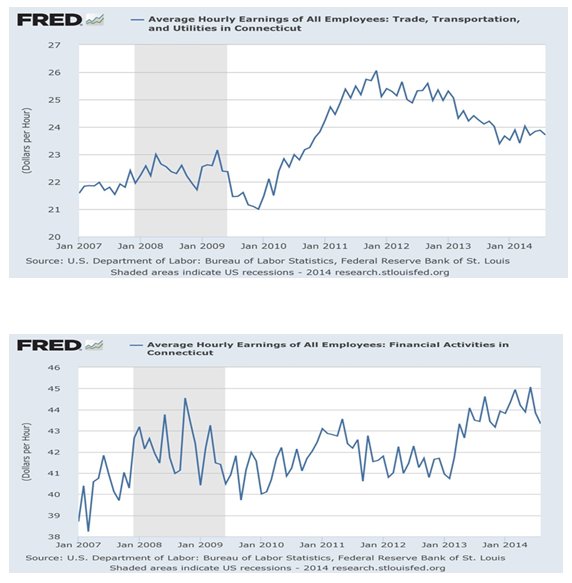
• Connecticut is not alone in experiencing sluggish wage
growth. A report issued by the United States Conference of Mayors in August
found that jobs added after the recession on average pay 23 percent less than
the jobs lost during the recession.
• Declining wages have been a continuing national concern because of their
impact on the consumer-driven U.S economy. Over the past four decades, even
during economic expansions, wage gains have not kept pace with economic growth.
Wages and salaries peaked at more than 51 percent of the economy in the late
1960s; they fell to 45 percent by the start of the last recession in 2007 and
have since fallen to 42 percent.
• According to a paper released by the San Francisco Federal Reserve, recent
college graduates are earning $692 a week or $36,000 per year. The wage premium
conferred by a college degree has been experiencing some erosion over time. The
influx of college graduates willing to work at lower wage levels combined with
the long-term unemployed beginning to return to the labor force has placed
downward pressure on all wages. The low wage growth indicates a continued labor
surplus market.
• Slow wage growth has resulted in a continued low interest rate policy
established by the Federal Reserve.
• The year-to-year change in the Consumer Price Index for All Urban Consumers
(CPI-U, U.S. City Average), not seasonally adjusted, increased at a 1.7-percent
rate in September.
• Based on data released by the Bureau of Economic Analysis on September 30,
personal income in Connecticut grew at an annualized rate of 5.2 percent in the
2nd quarter of 2014. This is the strongest rate of state income growth over the
last 5 quarters. The strongest gain came from interest, dividends and rents.
Third quarter results will be released on December 19.
• The chart below shows the annual trend in Connecticut personal income over
time. The 2014 estimate is based on annualizing 2nd-quarter results.
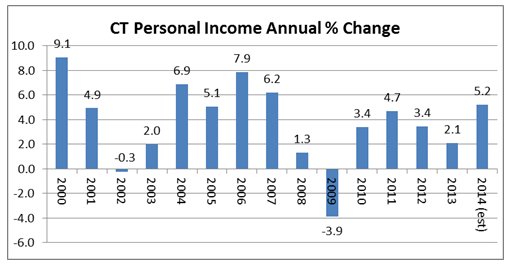

• The Real Estate Conveyance Tax continued to post solid double-digit growth
through September of Fiscal Year 2015 as compared to the same period last fiscal
year.
• According to a report from the Warren Group released on September 30,
single-family home sales in Connecticut year-to-date thru August of 2014 fell 2
percent from the same period one year ago. Sales in the single month of August
fell 5.6 percent from last August.
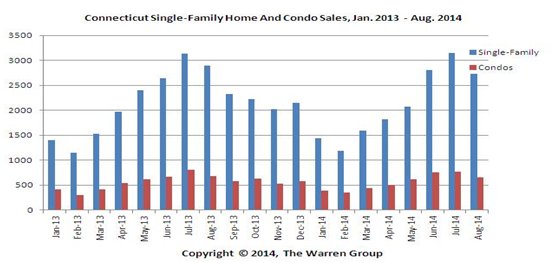
• Home prices fell 5.3 percent in August, the sixth consecutive month of price
decline. The median sales price of a single-family home statewide dropped to
$269,900 in August, down from $285,000 in August 2013.
• Condominium sales followed a similar trend in August.
• The National Association of Realtors reported that existing U.S. home sales in
September were down 1.7 percent from the same month last year; sales were up 2.4
percent in September from the prior month. Nationally, home prices grew by 5.6
percent from last September to $209,700.
![]()
• Estimated and final income tax payments were up 7.5 percent in September from
the same month last year. These receipts are correlated with capital gains and
stock market activity.
• At this writing, over the past 12 months the DOW has advanced 9.2 percent.
• On a year-to-date basis the Dow has risen at a more modest
2.6-percent rate.
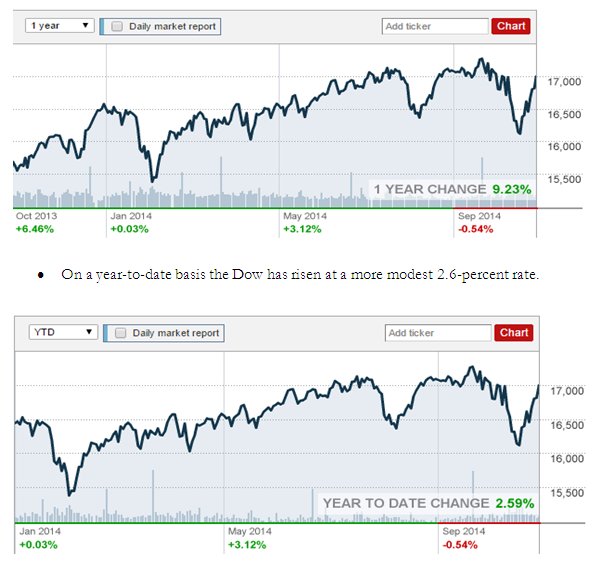
Consumers
• Sales tax receipts in September were 6.7 percent above September of 2013.
• September advance retail sales were up 4.3 percent from the same month last
year. This is slightly below the 4.5-percent pace set for the prior three-month
period.
• A consistent theme throughout 2014 has been solid automobile sales. Car sales
advanced 10.4 percent in September from one year ago. Food Services and drinking
places, health and personal care establishments, electronics and appliance
stores, and non-store retailers posted the strongest September gains. Gasoline
stations and department stores posted declining sales.
• The Federal Reserve reported that in August, consumer credit increased at a
seasonally adjusted annual rate of 5 percent. Revolving credit decreased at an
annual rate of 0.25 percent, while non-revolving credit increased at an annual
rate of 7 percent. Revolving credit (credit cards) has not experienced a
sustained decline since 2010.
Business and Economic Growth
• Based on the October 30 release by the Bureau of Economic
Analysis, real GDP increased at a rate of 3.5 percent in the 3rd quarter of
2014. In the 2nd quarter of 2014 real GDP increased at a 4.6-percent rate.
• The increase in real GDP in the 3rd quarter primarily reflected positive
contributions from personal consumption expenditures (PCE), exports,
nonresidential fixed investment, federal government spending, and state and
local government spending that were partly offset by a negative contribution
from private inventory investment. Imports, which are a subtraction in the
calculation of GDP, decreased.
• The deceleration in the percent change in real GDP reflected a downturn in
private inventory investment and decelerations in PCE, in nonresidential fixed
investment, in exports, in state and local government spending, and in
residential fixed investment that were partly offset by a downturn in imports
and an upturn in federal government spending.
• In the 2nd quarter, U.S. corporate profits posted an 8.4-percent gain from the
1st quarter, but profits advanced only 0.1 percent from the same quarter last
year. Results for the 3rd quarter will be available November 25.
• The Department of Labor's General Drift Indicators are composite measures of
the four-quarter change in three coincident (Connecticut Manufacturing
Production Index, nonfarm employment, and real personal income) and four leading
(housing permits, manufacturing average weekly hours, Hartford help-wanted
advertising, and initial unemployment claims) economic variables, and are
indexed so 1986 = 100. The index has been showing a general upward trend.

***END***
